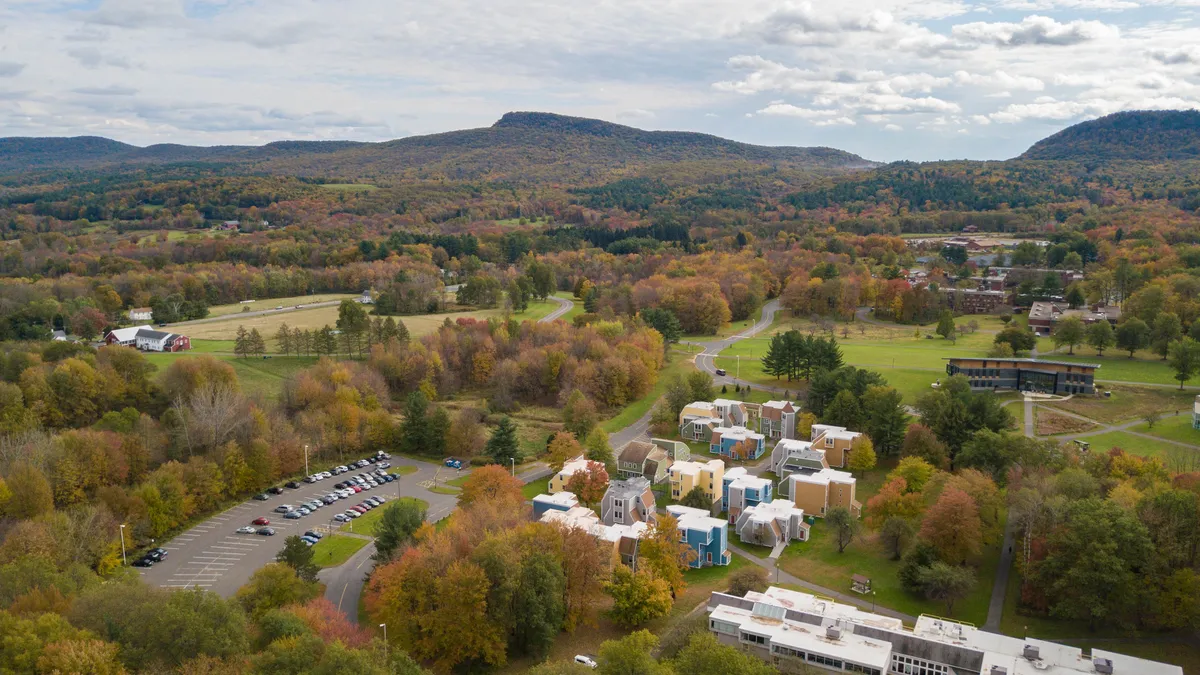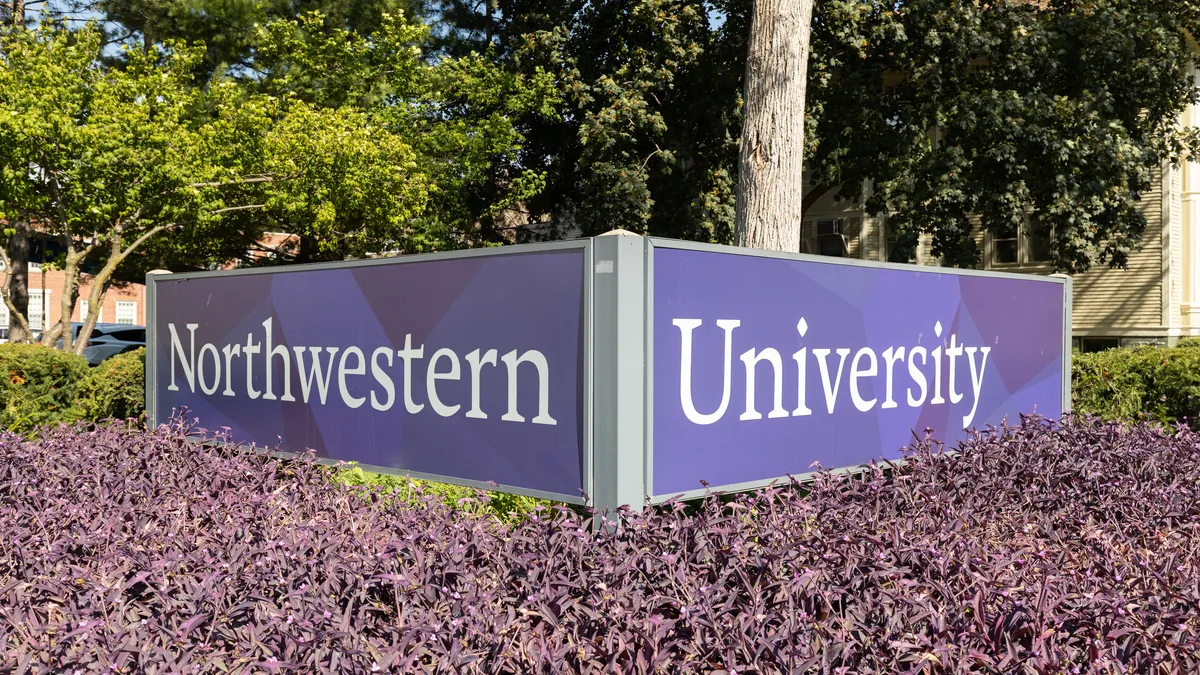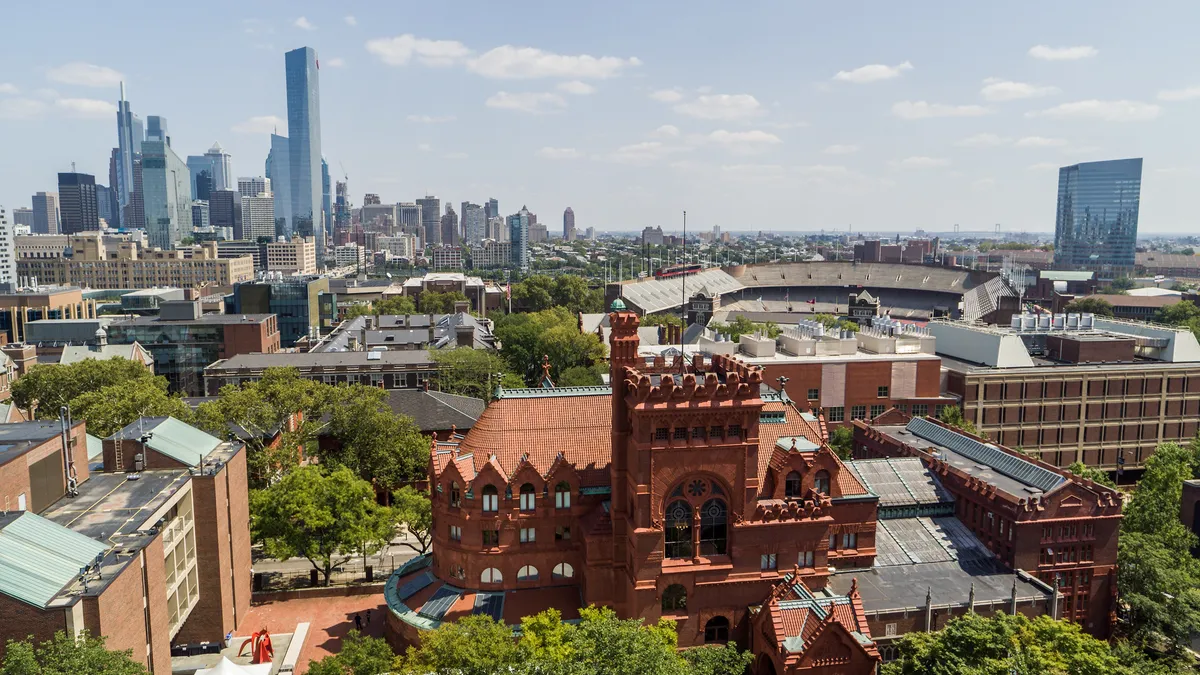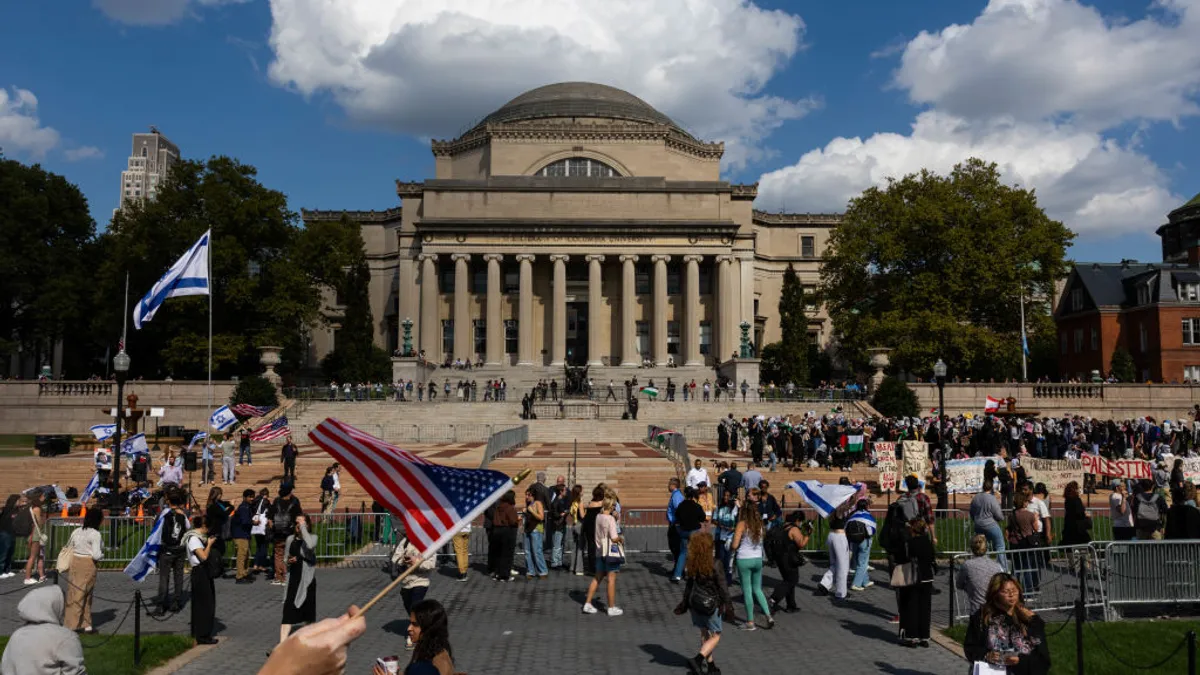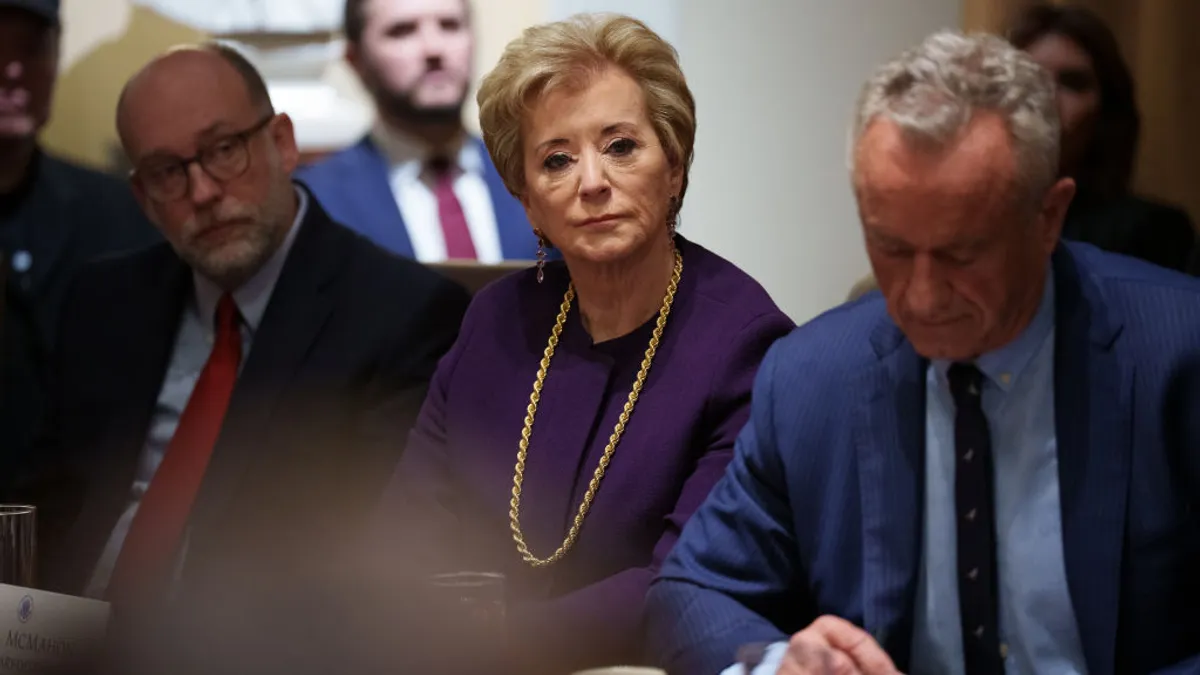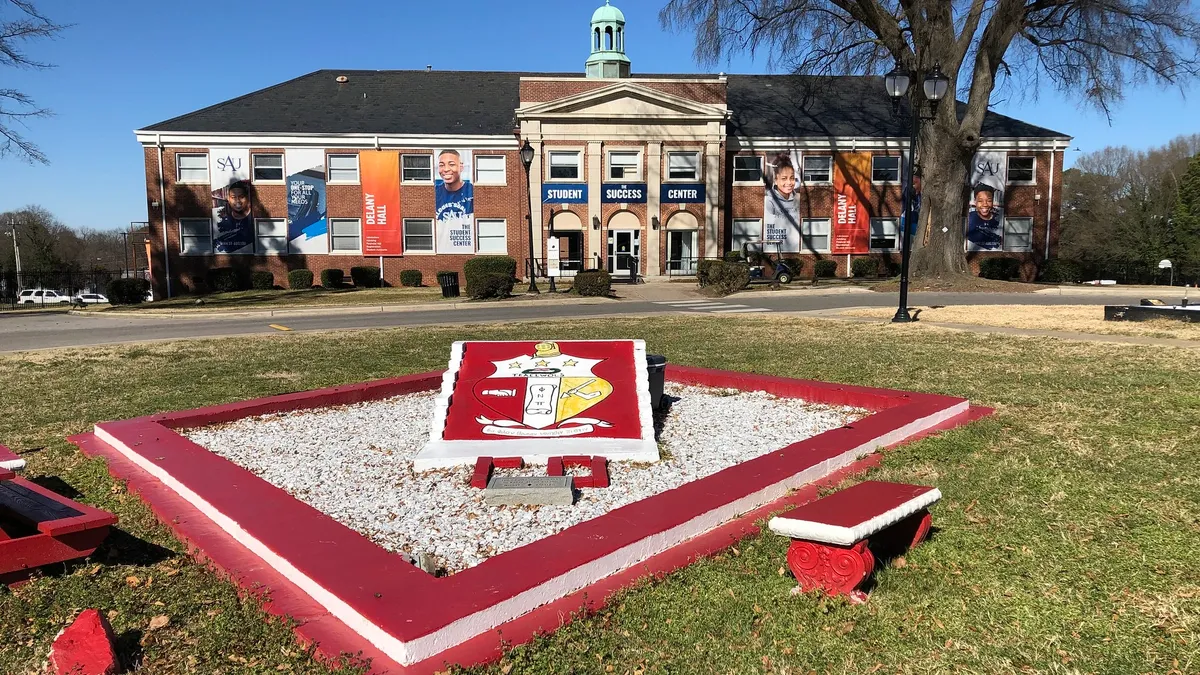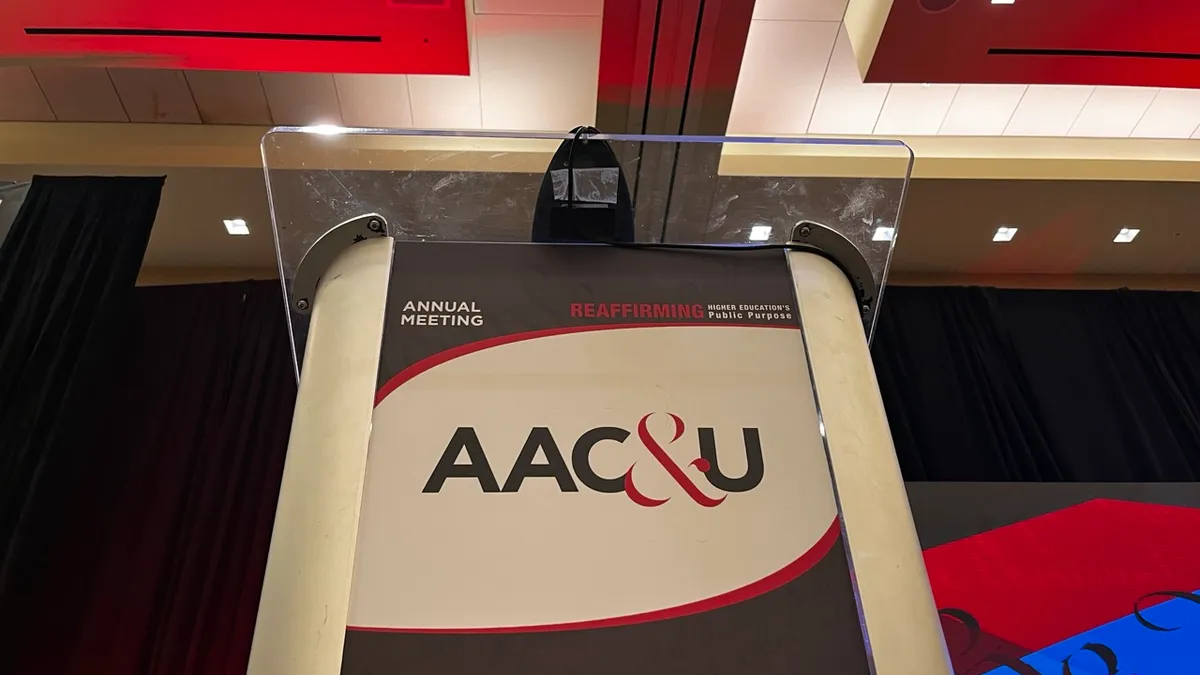Just five years ago, Hampshire College seemed destined for a very different fate.
The 54-year-old private liberal arts college in western Massachusetts teetered on the brink of closure due to financial constraints. It even opted not to admit a full incoming class of students — seemingly bound to close its doors just like many other small private nonprofits in recent years.
But since the 2019 financial crisis, the college’s leadership has led Hampshire on a path toward financial viability. Hampshire launched a $60 million fundraising drive, revamped its curriculum and went all-in on what President Edward Wingenbach described as one of the “most distinctive and interesting missions” in higher education: It is an experimenting college that aims to transform higher education, he said.
That has meant doing away with majors and departments and instead offering curriculum focused on addressing the world’s pressing issues, such as climate change and racial injustice.
“If we're going to be successful as an autonomous institution and reverse these financial challenges, it had to be by fundamentally committing to the mission and reinvigorating Hampshire's distinctiveness,” said Wingenbach.
Hampshire’s trajectory seems like it’s moving in the right direction, said Michael Horn, a higher education expert, podcast host and book author. The college’s enrollment has begun rebounding in the past few years and it is making strides in eliminating an annual deficit.
Other private colleges haven’t successfully turned around dire financial situations in the past few years. That includes Pine Manor College, a Massachusetts institution that announced plans to be taken over by the nearby Boston College in 2020, Mount Ida College, another Massachusetts institution that suddenly shuttered in 2018, and Iowa Wesleyan University, which closed last year.
Today, other college leaders are trying to learn from Hampshire and discussing making changes before they reach their own financial crises, said Mary Marcy, a higher ed consultant and former president of Dominican University of California.
“The fact that places like Hampshire do seem to be turning around is an encouraging message,” Marcy said.
Changing the curriculum
Hampshire’s success could provide a roadmap for other small colleges facing financial issues. But its turnaround was not easy.
The college’s plan centered around an experimental curriculum that focused on solving pressing world issues rather than teaching distinct majors. To that end, Hampshire eliminated interdisciplinary schools that functioned like departments, said Wingenbach. That meant faculty members no longer belonged to a single disciplinary area.
While officials executed their plan, the college was forced to launch a fundraising drive that Wingenbach equated to a “political campaign” to keep the college’s operations afloat.
“We told people, what we’re doing is exciting, it’s unique, it's interesting, it's engaging and setting the example for higher ed and you should support that,” said Wingenbach. That vision helped drive donations and prospective students, he said.
To close the structural deficit, the college needed to eliminate efforts that were not “mission-centered,” said Wingenbach.
For instance, Hampshire discontinued independent research centers that were not providing classes to undergraduates. Officials also advised its advancement office to focus entirely on raising funds for direct, unrestricted operating support — not planned giving — allowing the college freedom over how it used the money.
The changes brought new opportunities for students. The college last year created an optional course structure called “Semester Unbound,” where students spend an entire term on a single class oriented around a large project. Last fall, students developed a multi-year climate action plan for Hampshire.
Through the program, students have “immense flexibility to travel, to do intensive work, to not be constrained by the traditional structures of the classroom calendar,” Wingenbach said.
Individual faculty members previously adopted many of the ideals, practices and expectations that the new curriculum codified, said Omar Dahi, an economics professor at Hampshire and representative of the college’s American Association of University Professors chapter. That includes baking antiracism instruction or entrepreneurial skills into every students’ educational experience.
Through these changes, Hampshire sent a message to prospective students: If you care about climate change, if you care about resisting white supremacy, if you want to understand how to “conceptualize truth, in a post-truth era,” you can do that work at Hampshire College and be a part of a community that is engaged in that type of work, Wingenbach said.
Getting buy-in from faculty
From a faculty perspective, the 2019 crisis was “incredibly disruptive” and “a huge shock,” as professors feared they would soon be out of their jobs, Dahi said.
Many faculty members left the college following the 2019 crisis, including those who wanted to stay, said Dahi. While no faculty members were laid off, they did take negotiated leaves and some temporary salary reductions, he said.
Hampshire’s leaders slashed full-time equivalent faculty numbers from 118 during the 2018-19 academic year to just 65 the following year. By the 2022- 2023 year, faculty totals bottomed out to 45 — though they have slightly increased to 50 this academic year.
Dahi himself took a two-year unpaid leave to “be part of that effort to save the college” — taking a temporary grant-funded position at the nearby University of Massachusetts Amherst before returning, he said.
Faculty also grappled with the end of the college’s interdisciplinary school structure, including the elimination of the long-established social science and natural science schools, Dahi said.
Each school had “their own norms and ways of doing things, and you felt you had a home there,” he said.
However, faculty also felt a sense of pride in helping save the college, Dahi said. A sense of goodwill grew between faculty members and Wingenbach, who took office in the summer of 2019 after Miriam Nelson resigned from the post earlier that year.
Dahi said there was a greater level of transparency from Hampshire’s administration following the crisis than he had seen from the college’s leaders in the past, when decisions were often made arbitrarily, he added. That helped foster trust, even when decisions were not universally popular, he said.
“People can at least develop a trust that the decisions are made on things that are logical and predictable,” Dahi said. “That’s a major transformation.”
However, colleges don’t need to be on the brink of closure to get buy-in from faculty to make transformative reforms, Marcy said.
What matters is that Hampshire’s revision aligned with its historic mission, Marcy said. They didn’t drop everything and go fully online, for instance.
How close is Hampshire to financial viability?
Hampshire's admission rates and finances have been trending in the right direction.
This past fall, 724 students enrolled at Hampshire — a 59.5% increase from fall 2021 when just 454 students enrolled, according to data provided by the college. In fall 2018, prior to the financial crisis, 1,126 students were enrolled.
Meanwhile, the college received 2,411 applications for the 2023-24 academic year, an 82.7% increase from fall 2020. That figure is about flat with 2018’s pre-crisis numbers.
Wingenbach expects around 900 students will attend the college next year, and about 1,000 students the following year.
By 2026, Wingenbach said he believes the college will be able to eliminate its budget gap. By that point, the college will become fully sustainable based on tuition revenue, a normal annual fund, typical fundraising and regular endowment distribution, said Wingenbach.
According to the college, this year’s budget deficit — the amount it draws from its sustainability fund — sits at $3 million, which is far less than the $9 million the college drew the last academic year.
To bridge the budget gap, Hampshire has raised more than $40 million in unrestricted cash and pledges since the 2018-19 academic year, supporting the college’s operations as it transitions to a sustainably-sized institution, Wingenbach said.
Can other colleges follow Hampshire’s model?
Hampshire’s exact playbook is an anomaly, Horn said, and he’s not sure how much room there is in the higher ed sector for a dozen colleges just like it. But the general principles it followed can be applied at any institution — leaning into what differentiates the college, what would attract students and being clear about that, he said.
“That’s a playbook that anyone can follow, and should,” said Horn.
As president of Dominican University of California between 2011 and 2021, Marcy oversaw similar transformative changes. The university’s plan, which took roughly five years to carry out, streamlined the curriculum, made it easier for students to double major or double minor and ensured they all received certain “core experiences,” such as integrative coaching and community engagement, during their time at the institution, she said.
Under her leadership, Dominican University of California saw graduation rates and fundraising increase significantly.
According to Marcy, college leaders should ask themselves: If we were creating this institution today, holding onto the same values and mission, what would it look like?
“And then you have a lot of freedom to reimagine,” Marcy said.
But when investing in such a transformation, they also need to ascertain what kinds of resources and time they will need for it to be successful, she said.
“The fact that places like Hampshire do seem to be turning around is an encouraging message."

Mary Marcy
Higher ed consultant
One factor behind Hampshire’s success is that officials realized that they “can’t be all things to all people,” Horn said. “You’ve gotta lean into what your strengths are, and frankly, get out of the things that are your weaknesses.”
That can reduce administrative overhead and cut “extraneous” costs that affect financial sustainability, he said. It can also lower the necessity of maintaining departments that are ancillary to the college’s core mission. And it can provide clarity about who the institution is serving — ultimately serving those students better, Horn said.
A few years ago, when typing “Hampshire College” on Google, suggested searches included: “Is Hampshire College still open?” said Wingenbach.
Now they are receiving as many applications as they did prior to the financial crisis, and the quality of its application pool is “as good or better, is more diverse, and comes from a wider range of states or countries,” he said.
“That’s because of this excitement around a curricular approach that nobody else is doing, but captures why people value liberal arts education,” he said. “We end up with students who absolutely find this approach compelling.”


